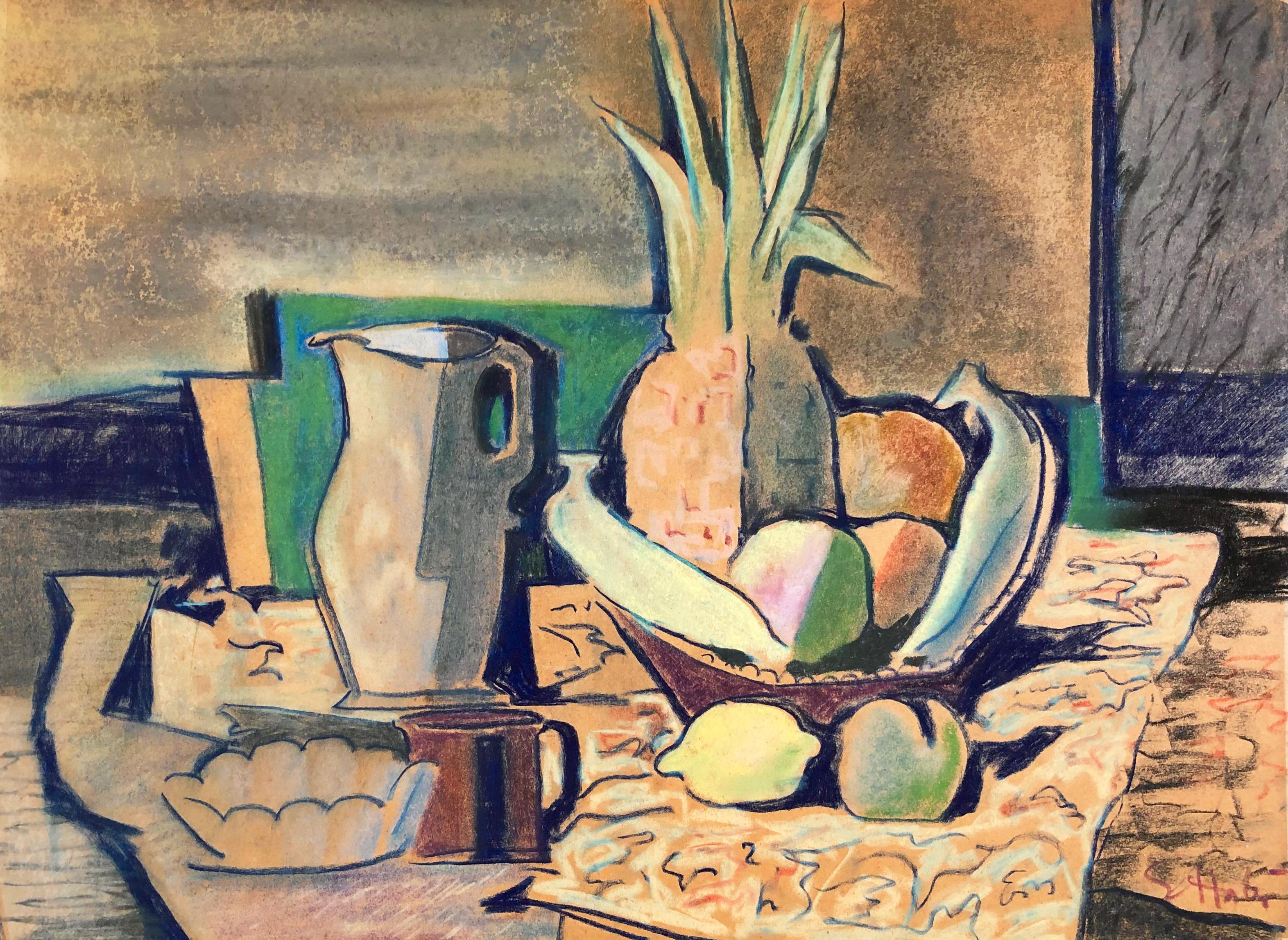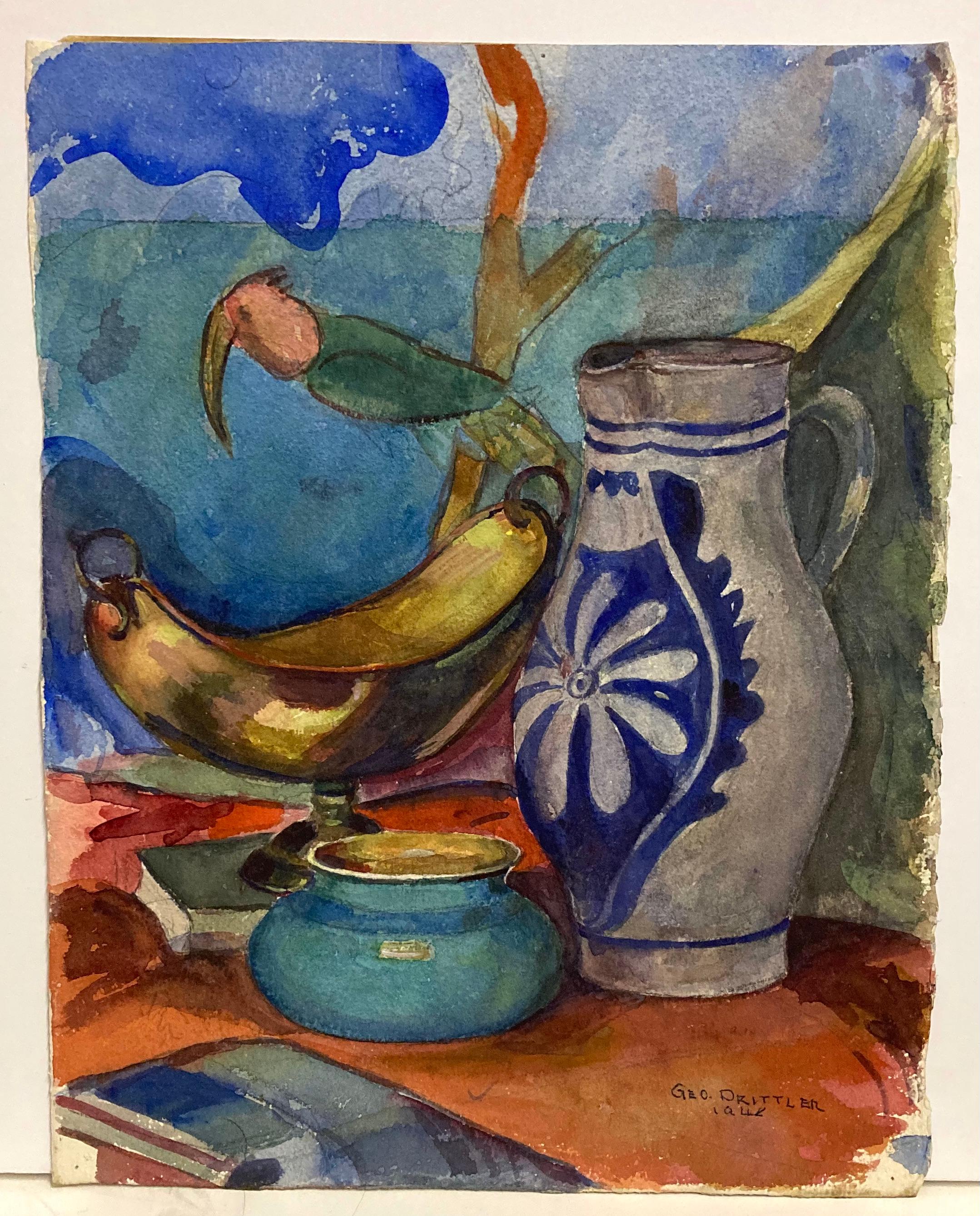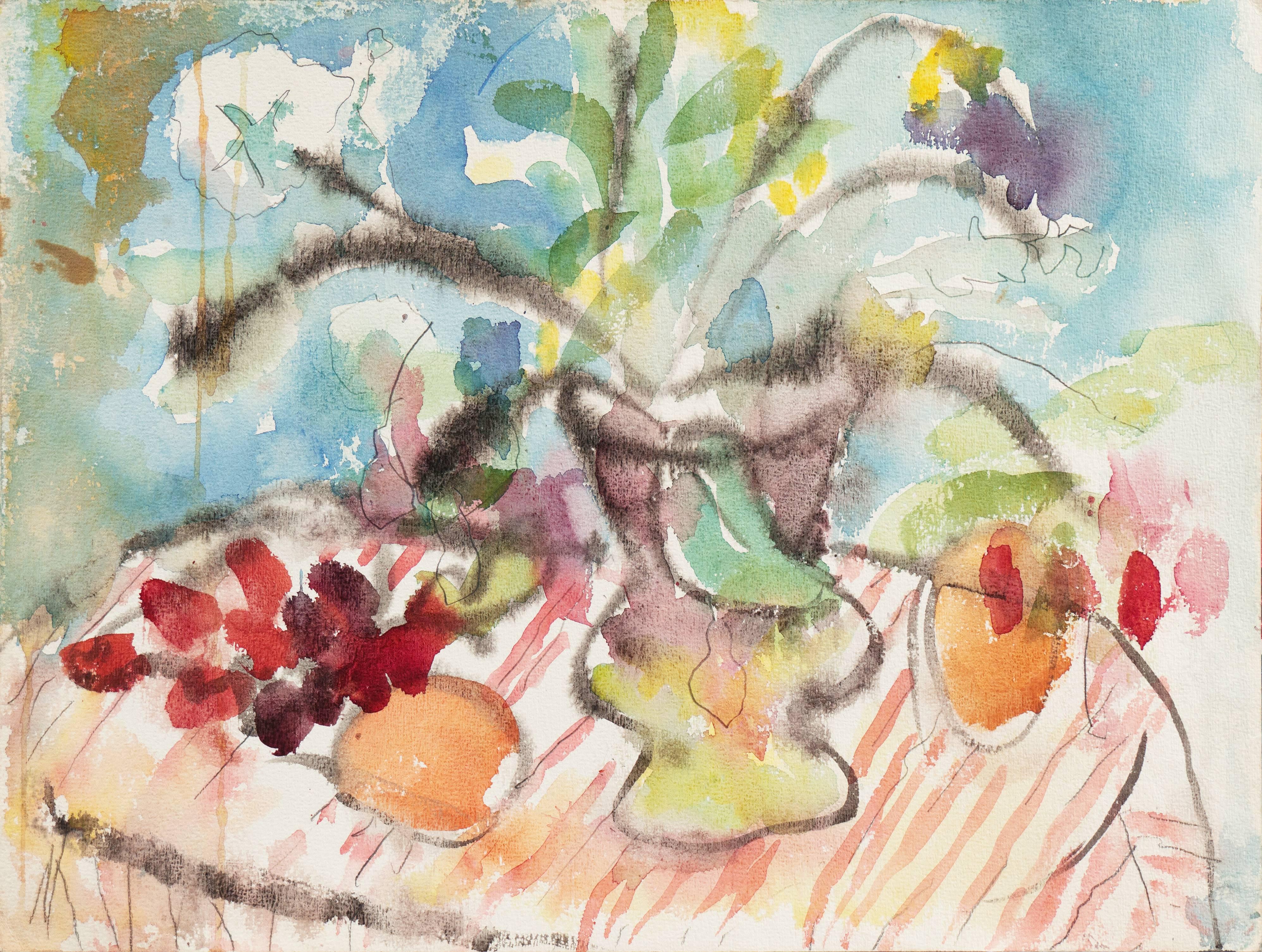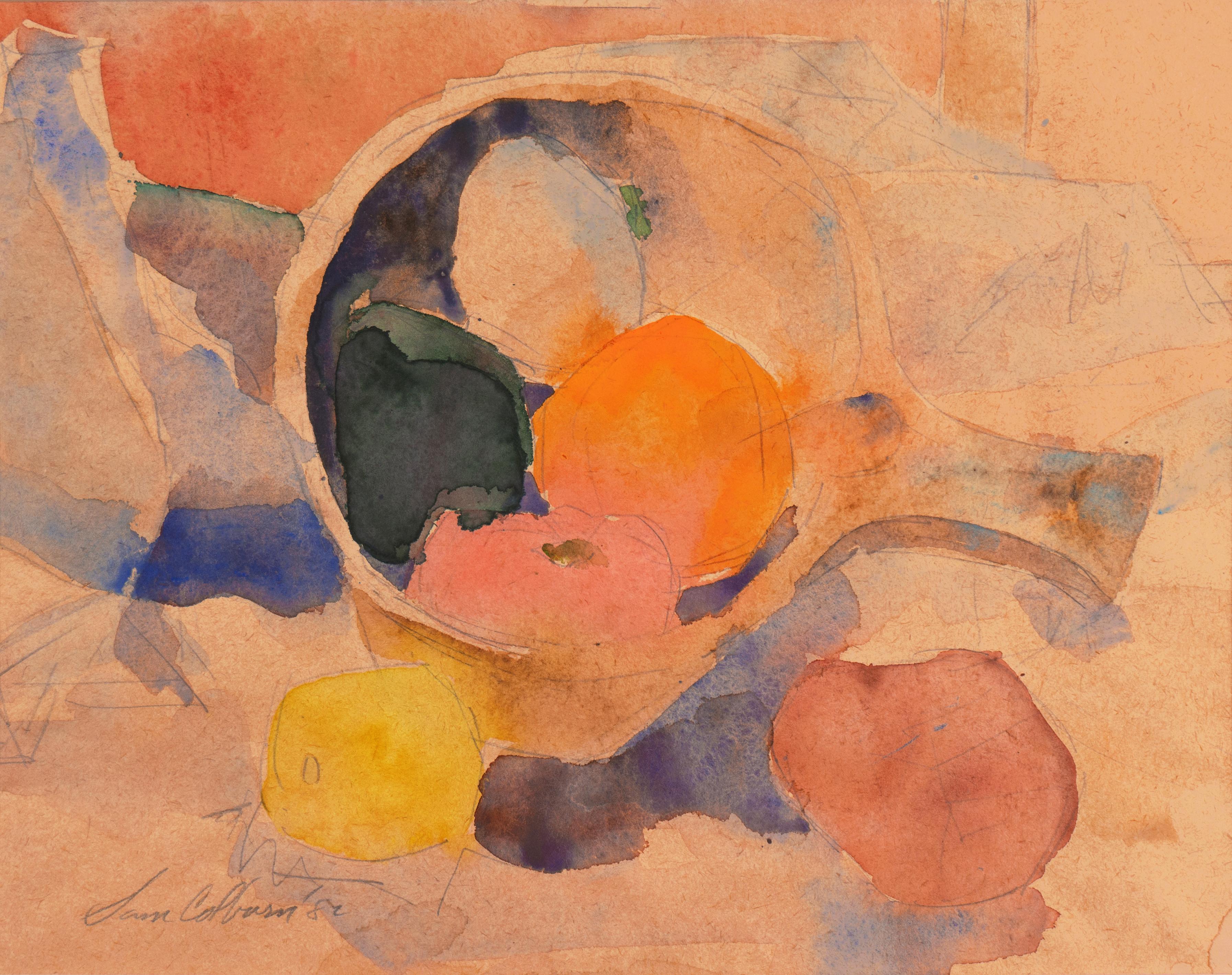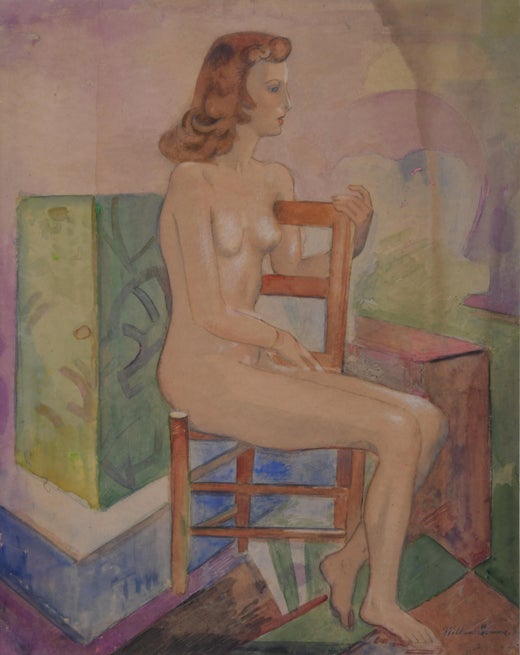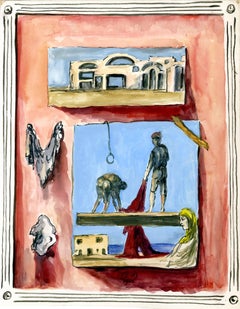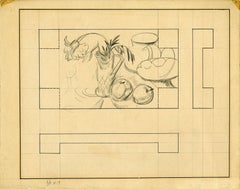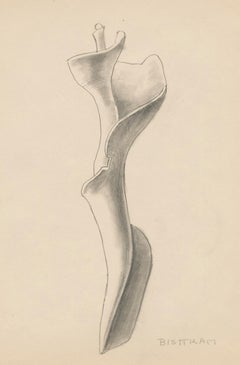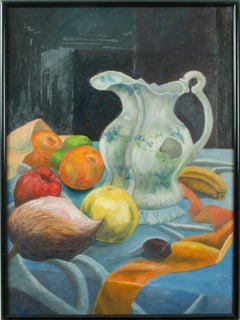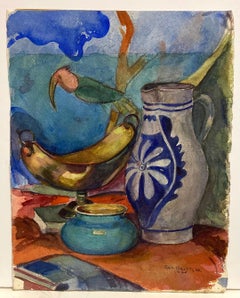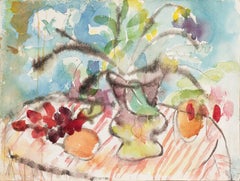Items Similar to Still Life with Tromp L'Oeil
Want more images or videos?
Request additional images or videos from the seller
1 of 11
William SommerStill Life with Tromp L'Oeilc. 1924
c. 1924
$3,000
£2,274.41
€2,621.80
CA$4,225.02
A$4,685.23
CHF 2,461.74
MX$57,245.59
NOK 30,799.76
SEK 28,910.83
DKK 19,572.22
About the Item
Still Life with Tromp L'Oeil
Graphite and watercolor on a book page.
Signed in ink by the artist lower right corner
(see photo)
Provenance:
Estate of the artist (Estate No. 00916 verso)
Ray Sommer (the artist's son)
Joseph M. Erdelac (No. 18 JME verso)
Book page verso is an illustration of a Durer woodcut.
William Sommer
(1867-1949)
William Sommer is seen as a key person in bringing European modernism to Northeast Ohio. He was born in Detroit, Michigan, and in his youth apprenticed for seven years to a lithographer.
He briefly studied at an art academy in Germany and then worked as a lithographer in New York before moving to Cleveland, where he was awarded a major contract with the Otis Lithography Company. There he became friends with sculptor and painter William Zorach, and the two, determined to be fine artists, began painting together on weekends. They also became intrigued by avant-garde movements, especially after Zorach's trip to Paris in 1910.
In 1911, Sommer co-founded a group in Cleveland called the Kokoon Club, a mixed group of commercial artists and radical modernists who sought the freedom to pursue their independent tendencies. They converted a tailor's shop into a studio and held exhibitions and lectures and organized an annual masked ball that became the focus of Cleveland's bohemian life.
In 1913, he and his colleagues began painting at Brandywine, about 30 miles south of Cleveland and made a school house into a studio. They devoted increasing time to watercolor painting because they could work spontaneously and it would dry quickly. Rejecting the conventional ideas of beauty, they strove for the expression of emotion and spontaneity and fantasy. One of Sommer's most successful students was Charles Burchfield.
As he was perfecting his mature style, he had financial difficulties because he made his living from commercial lithography, which was becoming obsolete, and the Depression was hitting the nation causing him to lose his job. He became a WPA artist, doing murals in northeastern Ohio.
After his death at age 82, he was largely forgotten until 1980 when Hilton Kramer, a "New York Times" critic, praised his work. In May to July, 1994, the Ohio Arts Council held a retrospective of his work at the Riffe Gallery in Columbus. His work is found in many public collections including the National Museum of American Art, The Metropolitan Museum of Art, and the Whitney Museum of American Art.
Courtesy, AskArt
- Creator:William Sommer (1867-1949, American)
- Creation Year:c. 1924
- Dimensions:Height: 16 in (40.64 cm)Width: 19.25 in (48.9 cm)
- Medium:
- Movement & Style:
- Period:
- Condition:Chipping around the edges. Repaired tears lower corners. Image: 8 1/2 x 11"; Frame: 16 x 19 1/8".
- Gallery Location:Fairlawn, OH
- Reference Number:Seller: FA89451stDibs: LU14015021472
William Sommer
William Sommer is seen as a key person in bringing European modernism to Northeast Ohio. He was born in Detroit, Michigan, and in his youth apprenticed for seven years to a lithographer. He briefly studied at an art academy in Germany and then worked as a lithographer in New York before moving to Cleveland, where he was awarded a major contract with the Otis Lithography Company. There he became friends with sculptor and painter William Zorach, and the two, determined to be fine artists, began painting together on weekends. They also became intrigued by avant-garde movements, especially after Zorach's trip to Paris in 1910. In 1911, Sommer co-founded a group in Cleveland called the Kokoon Club, a mixed group of commercial artists and radical modernists who sought the freedom to pursue their independent tendencies. They converted a tailor's shop into a studio and held exhibitions and lectures and organized an annual masked ball that became the focus of Cleveland's bohemian life. In 1913, he and his colleagues began painting at Brandywine, about 30 miles south of Cleveland and made a school house into a studio. They devoted increasing time to watercolor painting because they could work spontaneously and it would dry quickly. Rejecting the conventional ideas of beauty, they strove for the expression of emotion and spontaneity and fantasy. One of Sommer's most successful students was Charles Burchfield. As he was perfecting his mature style, he had financial difficulties because he made his living from commercial lithography, which was becoming obsolete, and the Depression was hitting the nation causing him to lose his job. He became a WPA artist, doing murals in northeastern Ohio. After his death at age 82, he was largely forgotten until 1980 when Hilton Kramer, a "New York Times" critic, praised his work. In May to July, 1994, the Ohio Arts Council held a retrospective of his work at the Riffe Gallery in Columbus. His work is found in many public collections including the National Museum of American Art, The Metropolitan Museum of Art, and the Whitney Museum of American Art.
About the Seller
5.0
Recognized Seller
These prestigious sellers are industry leaders and represent the highest echelon for item quality and design.
Platinum Seller
Premium sellers with a 4.7+ rating and 24-hour response times
Established in 1978
1stDibs seller since 2013
809 sales on 1stDibs
Typical response time: <1 hour
Associations
International Fine Print Dealers Association
- ShippingRetrieving quote...Shipping from: Fairlawn, OH
- Return Policy
Authenticity Guarantee
In the unlikely event there’s an issue with an item’s authenticity, contact us within 1 year for a full refund. DetailsMoney-Back Guarantee
If your item is not as described, is damaged in transit, or does not arrive, contact us within 7 days for a full refund. Details24-Hour Cancellation
You have a 24-hour grace period in which to reconsider your purchase, with no questions asked.Vetted Professional Sellers
Our world-class sellers must adhere to strict standards for service and quality, maintaining the integrity of our listings.Price-Match Guarantee
If you find that a seller listed the same item for a lower price elsewhere, we’ll match it.Trusted Global Delivery
Our best-in-class carrier network provides specialized shipping options worldwide, including custom delivery.More From This Seller
View AllTrompe-l'Oeil Study
By Eugene Berman
Located in Fairlawn, OH
Trompe-l'Oeil Study
Watercolor on heavy wove paper, 1943
Signed with the artists initials, lower center of image; Dated 1943, lower center of image
Provenance:
Swann Galleries, 2007, realized $2,640
Condition: Excellent. Fresh colors. Framed with conservation glass.
Sheet: 14 3/4 x 11 1/4"
Frame size: 20 3/4 x 17
Berman brothers (painters)
From Wikipedia, the free encyclopedia
Eugene Berman in Italy in the 1960s
Eugène Berman (Russian: Евгений Густавович Берман; 4 November 1899, Saint Petersburg, Russia – 14 December 1972, Rome) and his brother Leonid Berman...
Category
1930s Surrealist Still-life Drawings and Watercolors
Materials
Watercolor
untitled (Still Life with Apples and Vase of Flowers)
By William Sommer
Located in Fairlawn, OH
[recto];untitled (Sketches for Still
Unsigned
9 1/2 x 12 inches (24.2 x 30.6 cm.)
Category
20th Century Still-life Drawings and Watercolors
Materials
Graphite
Untitled, Still Life of Shell
Located in Fairlawn, OH
Untitled, Still Life of Shell
Graphite on paper, 1945-1951
Signed lower right in pencil "Bisttram" (see photo)
Condition: Excellent
Sheet size: 9.63 x 7 .5 inches
EMIL BISTTRAM (189...
Category
1940s American Modern Still-life Drawings and Watercolors
Materials
Graphite
Still Life with Fruit and a Pitcher
By Beni E. Kosh
Located in Fairlawn, OH
Estate stamp verso: Beni E Kosh Collection #436
Frame: 22-1/4 x 16-1/2 x 1-5/8"
Category
Mid-20th Century Contemporary Still-life Paintings
Materials
Oil
Still Life No. 5
By William H. Bailey
Located in Fairlawn, OH
Still Life No. 5
Lithograph, 1978
Signed, dated and numbered in pencil (see photos)
Edition: 50 (24/50)
Published by Solo Press, New York, 1978
Printer: Judith Solodkin, first femal ...
Category
1970s American Realist Still-life Prints
Materials
Lithograph
Still Life No. 5
By William H. Bailey
Located in Fairlawn, OH
Still Life No. 5
Lithograph, 1978
Signed, dated and numbered in pencil (see photos)
Edition: 50 (24/50)
Published by Solo Press, New York, 1978
Printer: Judith Solodkin, first femal ...
Category
1970s American Realist Still-life Prints
Materials
Lithograph
You May Also Like
Still Life
By Earl Horter
Located in Bryn Mawr, PA
Best known as an impassioned supporter and avid collector of modern art, Earl Horter was also an artist himself. Largely self-taught, Horter was a highly skilled draftsman and engrav...
Category
1930s American Modern Still-life Drawings and Watercolors
Materials
Paper, Pastel
Still Life #1
By Jerry Opper
Located in San Francisco, CA
This artwork "Still Life #1" c.1970 is a colors pastel and crayon on thick paper by American artist Jerry Opper, 1924-2014. It is hand signed in pencil at the lower right corner by the artist. The image size is 22 x 16 inches, sheet size is 24.25 x 18 inches. It is in excellent condition, there are pastel marks on the margin all around the artwork and also on the back, see picture #1.
About the artist:
Jerry Opper was born in Cleveland, Ohio, on September 5, 1924. He moved to Los Angeles with his family in 1933. After graduating from Hollywood High School, he worked in movie studios and attended art classes at Chouinard Art Institute. In May 1942, Opper was drafted into the army and was then able to study at the Colorado Springs Fine Arts Center while his outfit was stationed in Colorado. Later he was sent to Guam and was discharged in December 1945.
Opper returned to Chouinard and his work in movie studios until 1947, when he moved to San Francisco. He enrolled as a full-time student at the California School of Fine Arts (now SFAI) and received his diploma in June of 1950. In 1948, Opper met his wife Gertrud Ruth Friedmann, daughter of artist Gustav Friedmann, whose works are also in the Lost Art Salon collection. It was love at first sight and a few weeks after their first encounter at the Black Cat in San Francisco's North Beach, they got married and enjoyed a passionate, life-long romance.
Shortly after he finished school, Opper worked briefly as a decorator’s assistant and then started his career as a commercial artist, working for several firms such as Fibreboard, Beatrix Food and Precision. Working full-time and dedicating himself to having a rich family life occupied most of Opper's time, but he continued to be creative. He was above all a family man with the pride of having raised two exceptional daughters, Erika and Jody. Year after year, Opper would painstakingly craft their Halloween costumes...
Category
Late 20th Century American Modern Abstract Drawings and Watercolors
Materials
Pastel
George Drittler, (Still Life)
Located in New York, NY
British-born, New Jersey-based, George Drittler was primarily know for landscapes. In this still life that expansive approach serves him well. Richly drawn, with pottery, books and a...
Category
Mid-20th Century American Modern Still-life Drawings and Watercolors
Materials
Watercolor
'Still Life', Louvre, LACMA, Académie Chaumière, California Post-Impressionist
By Victor Di Gesu
Located in Santa Cruz, CA
Victor Di Gesu (American, 1914-1988) estate stamp verso and painted circa 1960.
Winner of the Prix Othon Friesz, Victor di Gesu first attended the Los Angeles Art Center and the Cho...
Category
1950s Still-life Drawings and Watercolors
Materials
Graphite, Watercolor, Paper
'Still Life', Chouinard Art School, Carmel Art Association, Santa Barbara Museum
Located in Santa Cruz, CA
Signed lower left, 'Sam Colburn' for Samuel Colburn (American, 1909-1993) and dated 1982.
A powerful, late work by this well-listed American regionalist and long-time member of the ...
Category
1980s Modern Still-life Drawings and Watercolors
Materials
Watercolor, Gouache, Mulberry Paper
Still life 1975. Paper, watercolor, 46x52 cm
Located in Riga, LV
Dzidra Bauma (1930)
Dzidra Bauma works in watercolor technique. She paint figural compositions, portraits, landscapes, flowers and still life. She is one of the most productive wate...
Category
1970s Impressionist Still-life Drawings and Watercolors
Materials
Paper, Watercolor
More Ways To Browse
Antique Book Pages
William Majors
Wpa Still Life
Durer Woodcut
Jackie Simmonds
Black And Gold Frame
Antique Signed Oil Painting
French Oil Paintings With Frame
American Lithographs
Landscape Paintings With Sky
Pop Art Signed Print
Vintage Art Times
Bright Contemporary Art
Painting Of Spring
21st Century Modern Paintings
Paintings From 1979
Modern Etching
Photographs Of Nature
